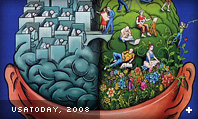Post
Just Animated Stardust
“Through science, we human beings are able to grasp at least some of nature’s secrets. We have cracked part of the cosmic code. Why this should be, just why Homo sapiens should carry the spark of rationality that provides the key to the universe, is a deep enigma. We, who are children of the universe – animated stardust – can nevertheless reflect on the nature of that same universe, even to the extent of glimpsing the rules on which it runs. How we have become linked into this cosmic dimension is a mystery. Yet the linkage cannot be denied.
“What does it mean? What is Man that we might be party to such privilege? I cannot believe that our existence in this universe is a mere quirk of fate, an accident of history, an incidental blip in the great cosmic drama. Our involvement is too intimate. The physical species Homo may count for nothing, but the existence of mind in some organism on some planet in the universe is surely a fact of fundamental significance. Through conscious beings the universe has generated self-awareness. This can be no trivial detail, no minor byproduct of mindless, purposeless forces. We are truly meant to be here.”
- Paul Davies
My last post on the evolution of consciousness discussed only briefly the development of the more complex aspects of our minds: the abilities that make us distinctly human and define the phenomenal aspects of our mental experience. The former is related to the idea of “cultural evolution”, while the latter will require an account of qualia.

The evolution of the advanced features of the brain seems difficult to explain. Is there a distinct selective advantage to being able to do calculus, and what is it that propelled us to such heights of cognition and reason (and so quickly)? Evolution is a very slow process, the insane complexity of all forms of life means that a chance mutation is far more likely to have no effect or break something than give any selectively advantageous abilities. As animals developed more advanced brains, they actually created a new scale of evolution (one that circumvented “traditional” evolution). Rather than evolving stronger muscles to hunt bigger prey, these thinking animals made tools that evaded the need for physical evolution in what became “cultural” evolution. Particularly advantageous is the fact that learned abilities can be expressed and selected for within a generation and passed on through teaching, significantly speeding up the evolutionary process (even allowing the species to take control of its own evolution).
The anatomical advancements needed to give the foundation for cultural evolution were not dramatic. The modularity of multicellular organisms means that a tiny surge of growth hormone or enzyme expression during fetal development could have drastic effects. The incredible abilities of prodigious savants are a good example (read more here), where slight modifications in specific areas allows for astonishing feats of calculation, memory, and art.
So, the rapid development of advanced and uniquely human mental abilities seems to arise from a physiological spark that launched a rapid cognitive evolution. This (r)evolution doesn’t get us to consciousness and qualia though. For that, I’ll expand on the case I made that the centralization of nervous matter created a more efficient mechanism for motor control through a complex self-image.

Just as motor reflexes and control were centralized, so were sensory input and interpretation. Early systems followed a very basic path, where a sensory stimulus (a ray of light, for example) triggered a response by activating a receptor. As organisms’ receptors developed into full-fledged sensory organs, their responses were mediated by interneurons and (after centralization/cephalization) integrating centers. Furthermore, the clear causal connection in the primitive system suggests that there’s no reason to believe there’s a physically inexplicable aspect in its more complex parent.
The consolidation of input and output into a central nervous system created environmental- and self-awareness (along with a repertoire of involuntary and voluntary responses). The two are tightly linked, environmental awareness through touch and proprioception help complete the self image, while self-awareness contributes to the vital interpretation of sensory input in relation to the self. The experience of this awareness is the “theater of the mind”, where we are constantly acquainted with both our surrounding environment and our awareness itself.
The dependence of consciousness and qualia on environment- and self-awareness (system-awareness) is visible in revealing neurological disorders. Disturbances of either component have a discernable impact on the level of consciousness. For example, a case presented in The Man Who Mistook His Wife for a Hat describes a patient who has suffered damage to a particular region of his visual cortex. As a result, the patient’s environmental-awareness (the combination of sensory input and representation) was significantly altered so that he actually did as the title says, grabbing his wife’s head and attempting to use it as a hat. In this case, the patient wasn’t actually seeing a hat where his wife stood, but the centers of the brain involved in painting a proper conceptual picture of his visual field wasn’t connecting things properly.
Similarly, one’s consciousness can be swayed by disturbances to the other component, self-awareness. The same book also describes a variety of “phantom limb” cases and the odd effects the loss of a limb can have on our consciousness. Several patients who’d suffered limb paralysis were also found to be in a strong state of denial, often refusing to acknowledge that their limb was actually paralyzed. The patients would try several activities requiring the use of both hands (carrying a tray, clapping), but would not see that they were unable to perform them. In fact, they actually perceived normal movement in their paralyzed limbs and in some cases the desired (but unrealized) result, like a clapping sound. When questioned directly about the extent of their paralysis, the patients’ minds were so averse to the possibility of paralysis that they would respond with nonsensical statements like “it’s not my arm”.
An organism’s awareness of itself and its environment is critical for its survival, and progressed from a basic reflex to the complex interpretation and subjective experience we enjoy as conscious humans. Whether or not Davies is justified in making his teleological leap in the quote above, there is no denying that we have a powerful gift in being able to explore our universe as agents within it. The experience of consciousness, of intensely vivid sensations, deeply personal and yet common amongst all of us, is unlike anything else in the universe.
Archive
-
260.
The Ethics of Practicing Procedures on the Nearly Dead
The report from the field was not promising by any stretch, extensive trauma, and perhaps most importantly unknown “downtime” (referencing the period where the patient received no basic care like...
-
260.
The Ethics of Teaching Hospitals
I can’t imagine what the patient was thinking. Seeing my trembling hands approaching the lacerations on his face with a sharp needle. I tried to reassure him that I knew what I was doing, but the...
-
260.
Conscious Conversation: Behavioral Science
Dr. Eran Zaidel is a professor of Behavioral Neuroscience and faculty member at the Brain Research Institute at UCLA. His work focuses on hemispheric specialization and interhemispheric interaction...
-
260.
Progress Report
Two years down, I’m still going. The next two years are my clinical rotations, the actual hands-on training. It’s a scary prospect, responsibilities and such; but it’s equally exciting, after...
-
260.
Why Medical School Should Be Free
There’s a lot of really great doctors out there, but unfortunately, there’s also some bad ones. That’s a problem we don’t need to have, and I think it’s caused by some problems with the...
-
260.
The Cerebellum: a model for learning in the brain
I know, it’s been a while. Busy is no excuse though, as it is becoming clear that writing for erraticwisdom was an important part of exercising certain parts of my brain that I have neglected...
-
260.
Conscious Conversation: Philosophy
Daniel Black, author of Erectlocution, was kind enough to chat with me one day and we had a great discussion – have a listen.
-
260.
The Stuff in Between
I’m actually almost normal when not agonizing over robot production details, and quite a bit has happened since I last wrote an update. First, I’ve finally graduated. I had a bit of a...



Comments
Thame, I love your blog..now, commenting on “just animated stardust” I agree with the quote from broflovsky, the minds awarness of itself is the basis for all reasoning..I have given this subject much thought and have come to realize the spiritual aspect of being human – a concept that western science seems to not want to be bothered with. I believe that the East has one up on us westerners when it comes to understanding our existence beyond a physical level…but i ask, what is mind? where is mind? is it a part of the brain or is it some part of the soul itself? ultimately, i understand that I am. We are floating on a planet in space and because of something or in spite of it; we simply “are”. I enjoy ur blog keep it up
“87” astronaut
astronaut
Sep 10, 02:20 PM #
Add a Comment
Phrase modifiers:
_emphasis_
*strong*
__italic__
**bold**
??citation??
-
deleted text-@code@Block modifiers:
bq. Blockquote
p. Paragraph
Links:
"linktext":http://example.com